The Iowa-class battleships, commissioned during World War II, represented the pinnacle of U.S. battleship design, boasting an unmatched blend of speed, armor, and firepower.
Today, all four ships—USS Iowa, USS New Jersey, USS Missouri, and USS Wisconsin—are preserved as museum vessels.
The tumultuous geopolitical landscape of the early 20th century, marked by the rise of powerful naval forces and global tensions, was the crucible in which the Iowa-class battleships were conceived.
As nations bolstered their naval assets and modernized their fleets, the U.S. found itself in a position where maintaining maritime supremacy was imperative, not just for strategic dominance but also to safeguard its interests and allies.
The Washington and London Naval Treaties of the 1920s and early 1930s, which aimed to prevent an all-out naval arms race, set tonnage limits for various categories of warships for the world’s major naval powers.
However, by the mid-1930s, with the re-emergence of aggressive expansionist policies in Japan and Germany, it was evident that the existing American battleship fleet might soon be outclassed by newer, more potent ships being laid down abroad.
Thus, the U.S. Navy began contemplating a new class of battleships that would be unmatched in firepower, speed, and armor. The keystone concept behind the Iowa-class design was to combine the heavy firepower of a battleship with the speed of a cruiser.
This combination was crucial for two reasons: to protect aircraft carriers, which were becoming the primary offensive naval weapon, and to ensure that these new battleships would never find themselves outrun by enemy vessels.
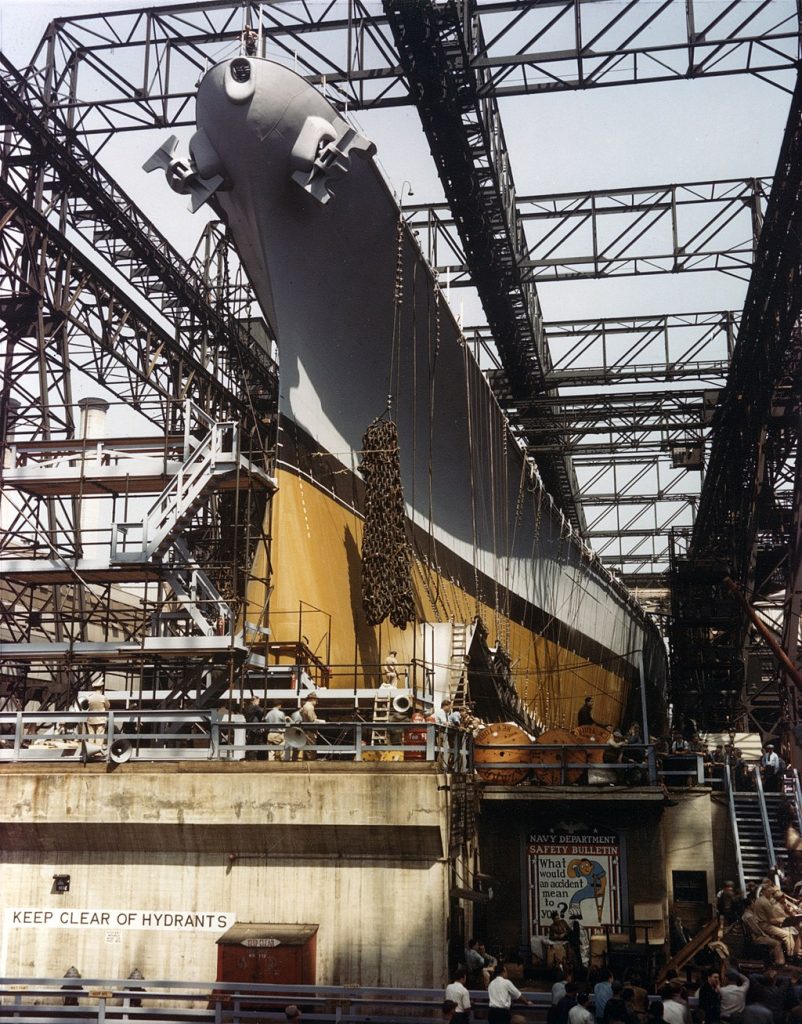 USS Iowa before her launch in 1942.
USS Iowa before her launch in 1942.
The first two ships, USS Iowa and USS New Jersey, were authorized in 1938. Recognizing the evolving nature of naval warfare, especially with the increasing importance of air power, the Iowa-class design also incorporated advanced anti-aircraft capabilities. They were meant to be not just floating fortresses, but also guardians of the fleet against aerial threats.
Simultaneously, innovations in shipbuilding, metallurgy, and propulsion were being made. These advances allowed the construction of larger, more robust ships with more powerful engines, ensuring that the Iowa-class battleships could maintain high speeds without compromising their formidable armor and armament.
Design Of The Iowa-Class
The design and engineering prowess behind the Iowa-class battleships embodied the zenith of battleship evolution. These floating leviathans were built with a precise balance of speed, armor, and firepower, positioning them as the vanguard of the U.S. Navy during their era of service.
Hull and Propulsion: One of the defining features of the Iowa-class was their long and slender hull, a departure from the typical battleship design. This elongated form, coupled with a state-of-the-art propulsion system, allowed these ships to achieve a remarkable top speed of 33 knots.
This design decision was strategic; by enabling the battleships to maintain pace with the faster aircraft carriers, they could effectively offer protection and firepower support to carrier strike groups.
Their propulsion system consisted of steam turbines powered by eight oil-fired boilers, driving four propellers—this provided the necessary thrust to move these 45,000-ton behemoths at such impressive speeds.
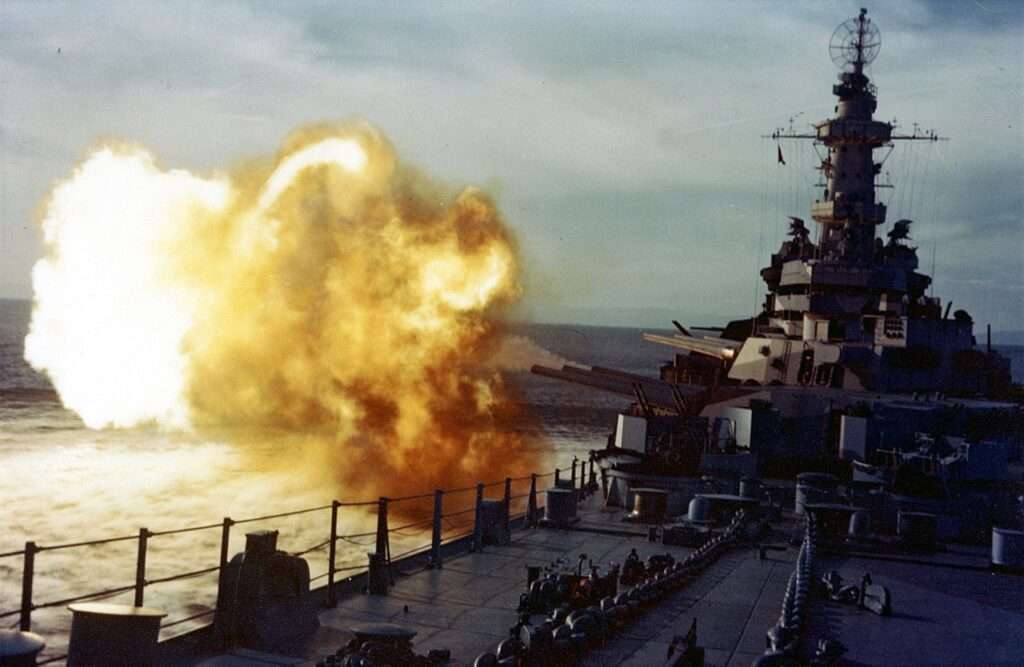 USS Missouri fires a salvo while on a shakedown, 1944.
USS Missouri fires a salvo while on a shakedown, 1944.
Primary Armament: The most dominant aspect of their design was undeniably their main battery: nine 16-inch/50 caliber Mark 7 guns, distributed in three triple turrets.
These colossal guns could fire 2,700-pound armor-piercing shells to distances exceeding 20 miles. This firepower was unparalleled in terms of its range and destructive capability, ensuring that the Iowas could engage enemy ships and coastal fortifications with devastating effect.
Secondary and Tertiary Armament: Complementing their primary firepower, the Iowa-class battleships were equipped with twenty 5-inch/38 caliber guns as their secondary armament. These were especially effective against smaller vessels and provided an additional layer of defense against aircraft.
Furthermore, for close-quarters defense and anti-aircraft warfare, they had an assortment of 40mm and 20mm guns. This comprehensive suite of weaponry ensured that the battleships could respond to threats from all quarters, whether they came from the air, sea, or land.
Armor and Defense: On the defensive front, the Iowa-class battleships were armored fortresses. Their belt armor, which protected their vital areas, was up to 12.1 inches thick, designed to withstand hits from heavy naval guns.
The armored deck ranged between 6 to 8 inches, offering protection against plunging fire and aerial bombs. Moreover, the turrets, conning tower, and other critical areas were heavily armored, ensuring that the ship and its crew had maximum protection against all forms of enemy ordnance.
Technological Innovations: Beyond raw firepower and armor, the Iowa-class incorporated a range of technological innovations. Advanced fire control systems ensured high accuracy even at long ranges.
Radar systems, a relatively new innovation of the time, gave them an edge in target detection and engagement, especially under adverse conditions.
Operational History
USS Iowa (BB-61)
Launched as the lead ship of her class, the USS Iowa was commissioned on February 22, 1943, and initially served in the Atlantic Fleet.
One of her early notable missions included transporting President Franklin D. Roosevelt to the Tehran Conference in November 1943, showcasing her importance beyond just combat roles.
As World War II progressed, the USS Iowa was transferred to the Pacific Fleet, where she played a crucial role in several pivotal battles.
Her service during this time included participation in the Marshall Islands campaign, the Battle of the Philippine Sea, and the Battle of Leyte Gulf.
The Iowa’s speed and firepower allowed her to escort fast carrier groups and provide formidable anti-aircraft support, as well as bombard enemy shore positions, demonstrating her versatility and strategic value in naval warfare.
Following the end of World War II, the USS Iowa was briefly used as a training ship before being decommissioned in 1949. However, the outbreak of the Korean War necessitated her return to service in 1951.
 USS Iowa in a floating drydock, December 1944.
USS Iowa in a floating drydock, December 1944.
During this conflict, she provided essential naval gunfire support against North Korean targets and played a key role in cutting off enemy supply lines. Her involvement in Korea further cemented her legacy, leading to her second decommissioning in 1958.
The Cold War era saw the USS Iowa reactivated in 1984 as part of President Ronald Reagan’s 600-ship Navy initiative. This period involved significant modernization, including the addition of Tomahawk and Harpoon missiles, enhancing her capabilities in the face of evolving threats.
Her duties primarily focused on operations in the North Atlantic and Mediterranean, aiming to deter Soviet influence and maintain a strong U.S. naval presence.
However, tragedy struck on April 19, 1989, when an explosion in one of her turrets killed 47 crew members, marking one of the darkest moments in her storied history.
USS Iowa was decommissioned for the last time on October 26, 1990, and after years in the reserve fleet, she found a new purpose as a museum ship.
USS New Jersey (BB-62)
Commissioned on May 23, 1943, this Iowa-class battleship quickly distinguished herself in the Pacific Theater of World War II.
She was actively involved in key operations, including the Marshall Islands, the Philippines, and Okinawa, providing crucial gunfire support for amphibious assaults and protecting aircraft carriers with her formidable anti-aircraft capabilities.
Her valiant service during these campaigns earned her numerous battle stars, underscoring her contribution to the Allied victory in the Pacific.
With the onset of the Korean War, the USS New Jersey was called back into service from the reserve fleet, recommissioned on November 21, 1950.
She played a vital role on the Korean Peninsula, offering naval gunfire support that proved instrumental in disrupting North Korean supply lines and fortifications. Her powerful 16-inch guns left a mark on the conflict, providing significant support to United Nations forces.
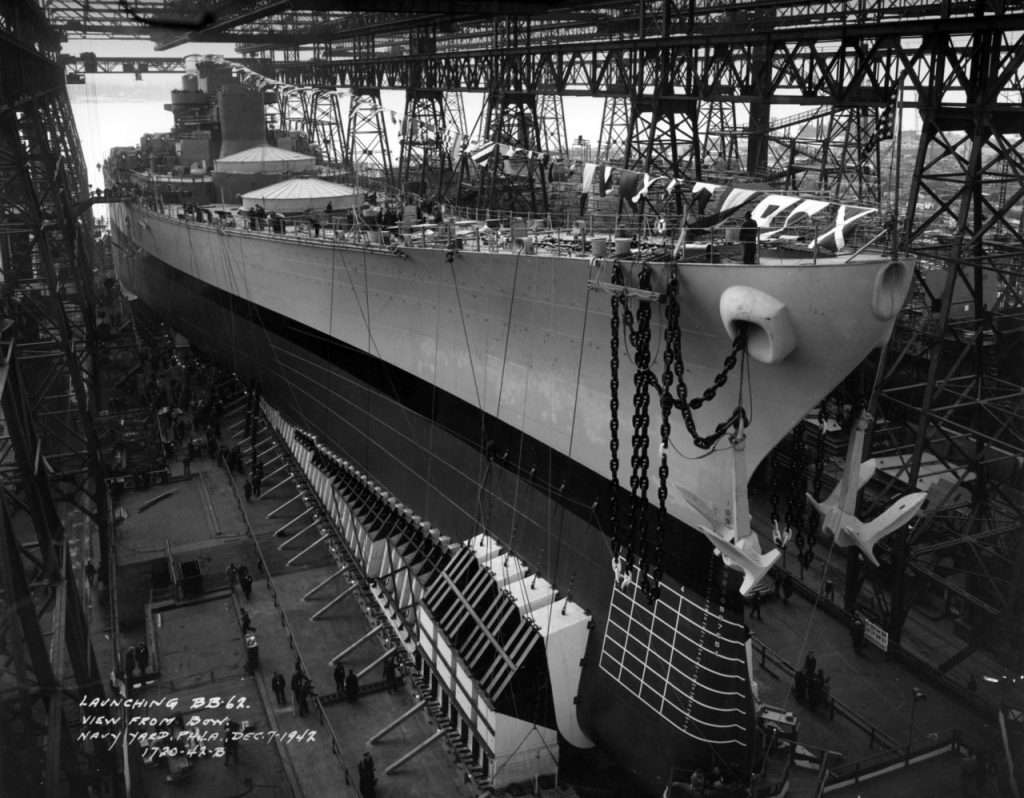 Launch of the USS New Jersey, 7 December 1942.
Launch of the USS New Jersey, 7 December 1942.
The USS New Jersey’s combat service continued into the Vietnam War, following a period in reserve. Reactivated in 1968, she was tasked with coastal bombardment missions that leveraged her unmatched firepower to support ground operations and disrupt enemy logistics as part of Operation Sea Dragon. Her contributions during this time further solidified her legacy as a versatile and potent weapon of war.
In the 1980s, as part of the 600-ship Navy initiative under President Ronald Reagan, the USS New Jersey found a new lease on life.
She was recommissioned and modernized to carry Tomahawk cruise missiles and Phalanx close-in weapon systems, enhancing her capability to project power and provide a strategic deterrence during the Cold War.
Notably, she was deployed off the Lebanese coast in 1983, providing critical gunfire support during the Lebanese Civil War, in one of the last instances of a battleship being used in combat.
The USS New Jersey was decommissioned for the final time on February 8, 1991. Today, she is preserved as a museum ship and memorial on the Camden Waterfront in New Jersey.
USS Missouri (BB-63)
Commissioned on June 11, 1944, she quickly entered into the fray of World War II, participating in key battles such as Iwo Jima and Okinawa. These operations were crucial in advancing U.S. forces closer to Japan, with Missouri playing a significant role in bombarding Japanese home islands.
Her place in history was cemented when she hosted the formal surrender of Japan on September 2, 1945, in Tokyo Bay, marking the end of World War II. This event on her deck symbolized not only victory in the Pacific but also the hope for lasting peace.
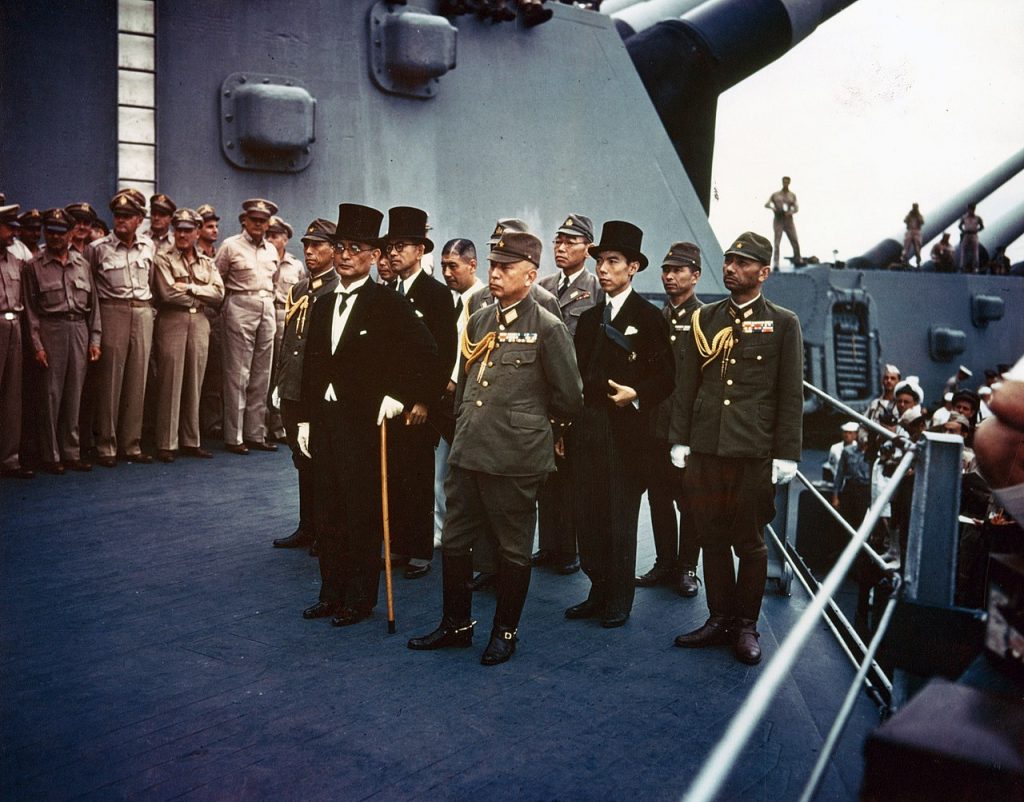 The Japanese representatives on board the USS Missouri before sigining the surrender.
The Japanese representatives on board the USS Missouri before sigining the surrender.
Following a brief period of inactivity, the outbreak of the Korean War saw Missouri recommissioned to provide naval gunfire support to United Nations forces.
Throughout the conflict, her powerful guns were a significant asset against enemy positions, showcasing her versatility and enduring value to naval operations.
However, with the advent of missile technology and changes in naval warfare strategy, Missouri was decommissioned in 1955, marking a temporary end to her active service.
The 1980s brought about a resurgence in interest in naval power under President Ronald Reagan’s 600-ship Navy policy, leading to Missouri’s reactivation and modernization.
Equipped with Tomahawk missiles and advanced targeting systems, she was transformed into a modern battleship capable of delivering precision strikes.
This modernization was put to the test during Operation Desert Storm in 1991, where Missouri launched Tomahawk missiles and conducted bombardment missions against Iraqi targets, effectively participating in her last combat action.
In 1992, the USS Missouri was decommissioned for the final time, transitioning from an active warship to a revered museum ship. Today, she rests at Pearl Harbor, Hawaii, near the USS Arizona Memorial.
USS Wisconsin (BB-64)
Commissioned on April 16, 1944, the USS Wisconsin quickly joined the Pacific Fleet, contributing to the final phases of the island-hopping campaign aimed at bringing the fight closer to Japan.
Wisconsin participated in the battles of the Philippine Sea and Leyte Gulf, providing gunfire support for troop landings and engaging Japanese naval forces. As the Allies pushed closer to Japan, Wisconsin supported the Iwo Jima and Okinawa campaigns.
With the outbreak of the Korean War, Wisconsin was recommissioned in 1950 to provide naval gunfire support for United Nations forces on the Korean Peninsula.
She played a crucial role in bombarding enemy positions, offering critical support for ground troops and disrupting North Korean supply lines. Her powerful 16-inch guns made her an invaluable asset in the naval operations throughout the conflict.
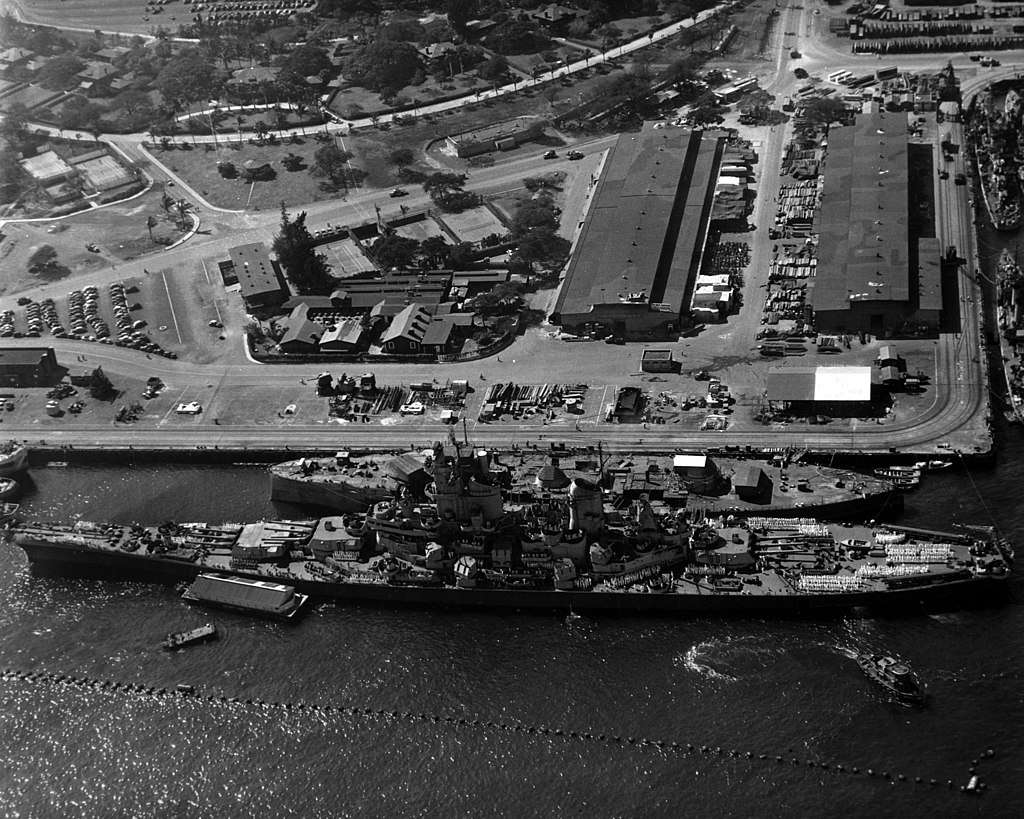 USS Wisconsin tied up alongside USS Oklahoma at Pearl Harbor, November 1944.
USS Wisconsin tied up alongside USS Oklahoma at Pearl Harbor, November 1944.
Following her service in Korea, Wisconsin was decommissioned but remained in the reserve fleet, ready to be called back into service if needed.
This call came in the 1980s when Wisconsin was modernized and recommissioned. Her modernization included the addition of Tomahawk cruise missiles and Phalanx close-in weapon systems, enhancing her capabilities to meet the demands of modern warfare.
Wisconsin’s combat service concluded with her deployment to the Persian Gulf during Operation Desert Storm in 1991.
In this conflict, she fired Tomahawk missiles at Iraqi targets and provided gunfire support for coalition forces, proving the value of battleships in providing precise and powerful shore bombardment.
After the successful conclusion of the Gulf War, Wisconsin was decommissioned for the final time.
Today, the USS Wisconsin is preserved as a museum ship, berthed at the Nauticus maritime museum in Norfolk, Virginia.
Legacy Of The Iowa-Class
The Iowa-class battleships, while no longer active in modern naval warfare, leave behind a rich legacy that transcends their military contributions. Their significance extends to the realms of engineering, history, diplomacy, and education.
In a testament to their enduring importance, all four have been preserved as museum ships, ensuring that their stories and the tales of those who served aboard them continue to be told to future generations.
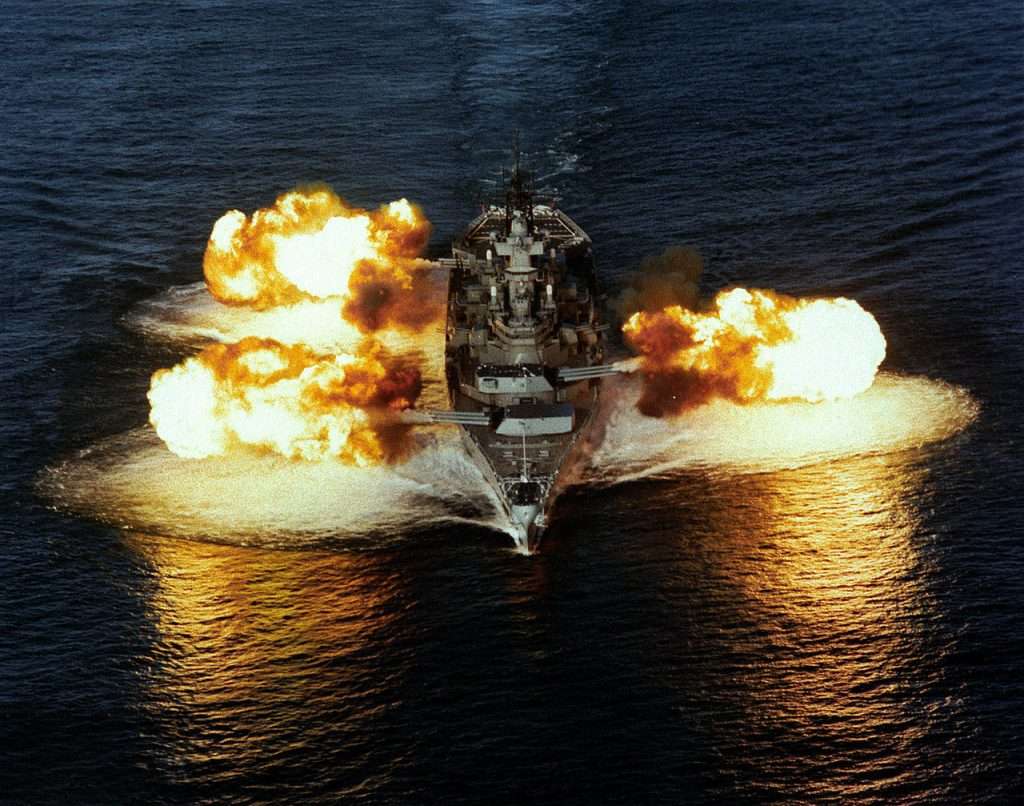 USS New Jersey firing her main guns in Korea.
USS New Jersey firing her main guns in Korea.
From an engineering perspective, the Iowa-class battleships represent the culmination of battleship design, reflecting innovations in metallurgy, propulsion, and weapons technology.
Their combination of speed, firepower, and armor was unmatched, setting benchmarks in naval architecture that students and enthusiasts continue to study and admire.
These ships bore witness to some of the most pivotal moments in 20th-century history. The USS Missouri, for instance, was the site of the Japanese surrender on September 2, 1945, effectively ending World War II. Such moments immortalize these vessels as not just tools of warfare, but as stages where history was made.
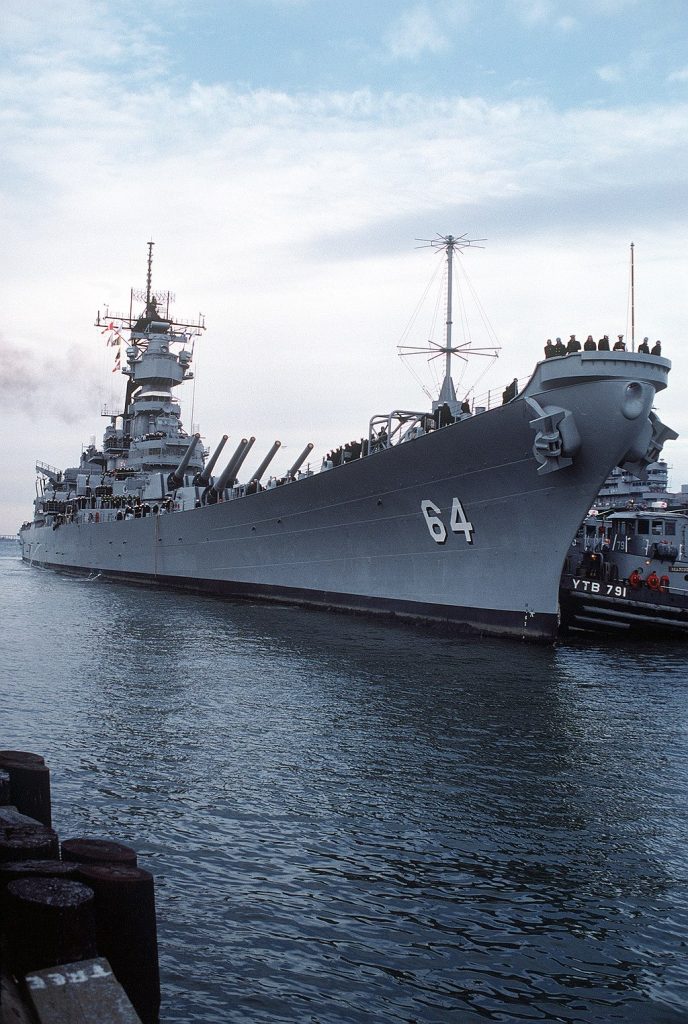 USS Wisconsin maneuvered into port, 1988.
USS Wisconsin maneuvered into port, 1988.
Throughout the Cold War, the mere presence of an Iowa-class battleship during diplomatic engagements or naval exercises underscored American commitment and resolve.
They became symbols of American naval power and were often used as tools of “gunboat diplomacy”, acting as deterrents and reminders of the U.S.’s ability to project power across the globe.
Today, each of the four Iowa-class battleships—USS Iowa, USS New Jersey, USS Missouri, and USS Wisconsin—serves as a floating museum. These vessels offer visitors a tangible link to the past, allowing them to explore the decks, turrets, and living quarters.
Interactive exhibits, guided tours, and veteran-led narratives ensure that the history of these ships, and the broader context of naval warfare, remains accessible to all. They also serve as platforms for honoring the men and women who dedicated their lives to naval service.
Beyond their military and educational roles, these battleships have found their way into popular culture. They’ve been featured in films, documentaries, and literature.
In preserving the Iowa-class battleships, the U.S. not only pays homage to the past but ensures that the lessons, stories, and values associated with them continue to resonate.
These floating museums serve as reminders of the sacrifices made, the innovations achieved, and the pivotal role naval power has played in shaping the course of history.